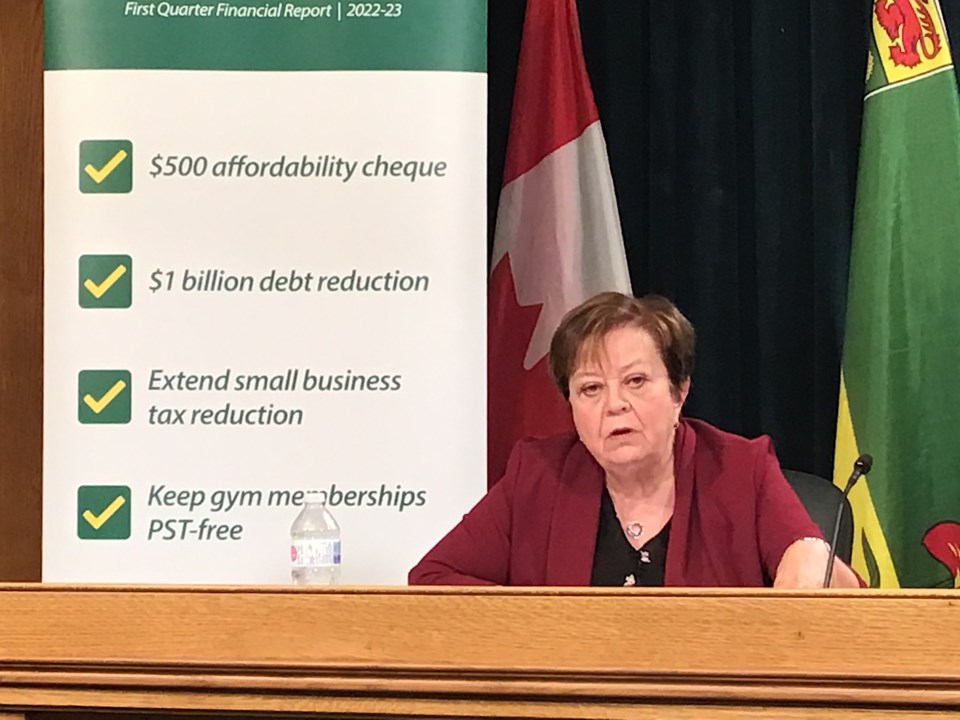REGINA - Finance Minister Donna Harpauer released details about Saskatchewan’s first quarter financial update on Tuesday at the legislature.
Here are five things to know about those numbers:
1. Province to post surplus of $1.04 billion for 2022-23.
At the first quarter, Saskatchewan is forecasting a surplus of $1.04 billion for 2022-23, a $1.51 billion improvement from the budget. It will be the first balanced budget for the province in a number of years.
One reason is due to a strong economy, with Saskatchewan's real GDP now expected to grow by 4.7 per cent in 2022, and is expected to lead the provinces in economic growth. Harpauer said the province is “firing on all cylinders,” and states the province is at or near the top of poised to lead all provinces in economic indicators.
The other is the boost in resource revenue. Harpauer also points to a $2 billion improvement in provincial revenue due from non-renewable resources owned by the people of Saskatchewan, mainly potash and oil.
"While that's good news, it also means the cost of almost everything you buy has gone up," Harpauer said. "These resources belong to all Saskatchewan people. Saskatchewan people should benefit from higher resource prices and higher revenues.”
Here are some key facts and figures:
For the first quarter, revenue is forecast to be $19.17 billion, up $2.02 billion (11.7 per cent) from budget. This is largely due to a $1.86 billion increase in non-renewable resource revenue from higher potash and oil prices.
Taxation revenue is forecast to be up $536.5 million from budget, with higher income and sales tax revenue reflecting stronger than anticipated economic recovery. There is also an increase in other own-source revenue and federal transfers, but the increases are being offset partially by a projected $533 million decrease from budget for net income from Government Business Enterprises due to lower investment income and higher natural gas prices.
Expenses are also up for the first quarter, with total expense forecast to be $18.13 billion, up $508.2 million or 2.9 per cent from budget. This is largely due to $450 million for the one-time Saskatchewan Affordability Tax Credit payments.
2. Affordability plan includes $500 tax credit cheque
In response to inflation and affordability issues facing Saskatchewan residents, Harpauer has announced a four-point affordability plan.
As was announced by Premier Scott Moe on social media on Monday, all Saskatchewan residents who are 18 years of age or older as of Dec. 31, 2022, and who have filed a tax return, will receive a one-time $500 Saskatchewan Affordability Tax Credit cheque this fall.
These will be physical cheques that will be sent out in the mail. Harpauer said these will be mailed out by the end of November, but it may be a little later for those who haven’t filed.
If you did not file a 2021 return, you can still file a return by the end of October and qualify for the tax credit.
Harpauer did admit there had been thought of doing other measures, such as rolling back the SaskPower rate increase. In the end, Harpauer said the affordability tax credit was a way to distribute the funds “in a very fair and equitable way,”also noting that this will cover many months of a utilities increase.
3. Gym memberships to stay PST free
The affordability plan also excludes gym and fitness memberships, and some children’s recreational activities that had previously been part of the planned Oct. 1 expansion of the PST to include admissions, entertainment and recreation.
The thinking, said Harpauer, is the rollback would help make life more affordable. Unfortunately, tickets to such events as Riders game will still see the PST increase imposed.
As for why the government did not roll back the entire PST expansion, Harpauer noted it was a “balanced decision that we have to make. We still are very mindful that should prices fall, we still have and still will be expanding in healthcare and education costs, and we still need a revenue stream to cover that, albeit small. Everything helps.”
4. Small business tax reduction extended
The province is also announcing they will continue the temporary small business tax reduction at zero per cent, retroactive to July 1, 2022 and continuing through to July 1, 2023.
This is a one year extension which Harpauer said is designed to help small businesses continue to recover from the pandemic as well as face new challenges such as inflation, interest rate hikes, supply chain issues and labour challenges.
5. Debt to be retired by a billion
The province has announced it will retire up to $1 billion in provincial debt. Public debt is forecast to be $1.72 billion lower than at budget, as the projected return to surplus will mean less borrowing and lower interest charges. It’s estimated the province will save nearly $50 million in interest charges, which will be reinvested in Saskatchewan.
Harpauer said the province will be retiring $1 billion and not borrowing $900 million, and the province will be in the fiscal position to borrow $130 million less for their capital plan. But she said the Crown corporations have informed them they will have to borrow an additional $300 million, so the net of all that is for public debt to be $1.72 billion lower than budget.



